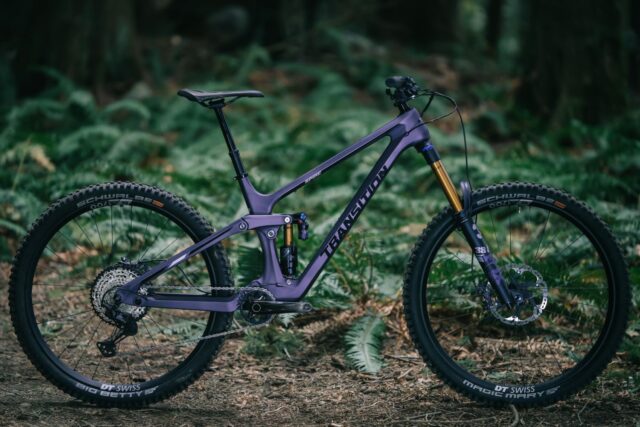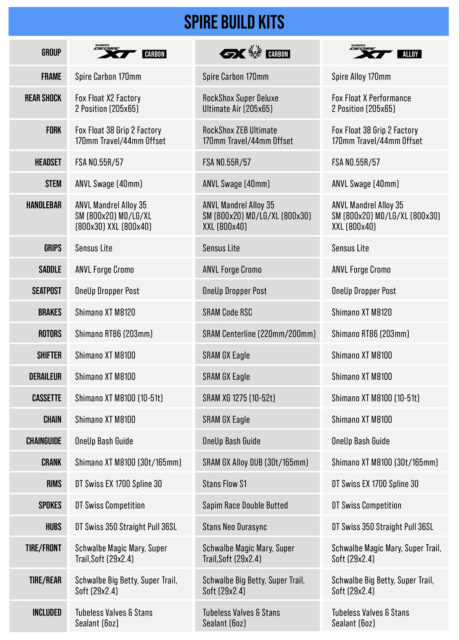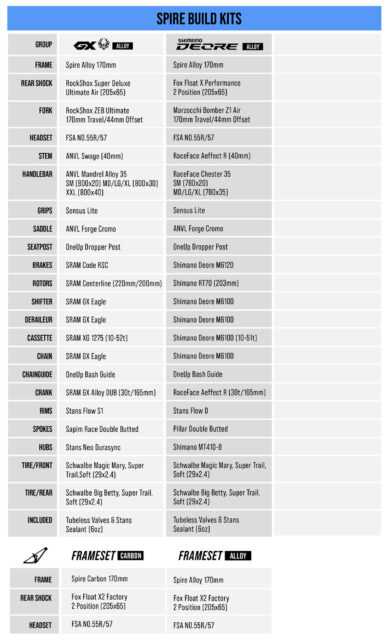2021 Transition Spire
Geometry: See below
Wheel Size: 29’’; compatible with 27.5’’ rear wheel
Travel: 170 mm rear / 170 mm front
- [or 160 mm rear w/ a 60mm-stroke shock, down from the stock 65 mm]
MSRP:
- Frameset: $2,299 – $3,399
- Complete bikes $3,799 – $6.699

Intro
The Sentinel has been Transition’s longest-travel 29er for years now, and while it’s a very capable bike in its own right, it’s got less travel and a bit more moderate geometry than many of the biggest, burliest bikes that have recently entered the category, such as the Nukeproof Giga, Nicolai G1, and Propain Spindrift.
Enter, the Spire — Transition’s longest-travel 29er to date. They call it a “nimble bruiser,” and with 170 mm of travel at both ends and a 62.5° headtube angle, it certainly looks to have the “bruiser” part of that statement on lock. But given the rise of these sorts of bikes, the question is, what really sets the Spire apart from the competition? And what about that new mulleted Patrol that Transition released a few days ago? Let’s dive into the details:
The Frame
While the Spire looks like a whole lot of bike on paper, Transition makes it clear that they don’t mean it to be a one-trick pony that only feels at home going downhill in super gnarly terrain. As they put it, “the Spire blends DH bike capability with mid-travel efficiency in such a way it’s almost two bikes in one.”
While the new Patrol is available in aluminum only, aluminum and carbon versions of the Spire are on offer. Transition’s familiar design language carries over, including a Horst link suspension layout with a vertically-oriented shock. Rubber guards for the seatstay, chainstay, and downtube come pre-installed, and an additional shuttle guard is included in the box. Cable routing is fully internal, a full-size water bottle fits inside the front triangle on all sizes, and there’s a second set of accessory mounts underneath the top tube.

As with the new Patrol, the Spire features a flip chip at the lower shock mount to toggle between two geometry settings (more on that in the Fit and Geometry section below). Unlike the Patrol, Transition does say that you can run your choice of wheel size on the Spire, with mullet compatibility in the high geometry setting. The Spire comes with a 205 x 65 mm trunnion-mount shock, which produces 170 mm of rear-wheel travel, but it’s possible to use a 205 x 60 mm shock if you want to drop the rear travel to 160 mm.
Like the new Patrol, the Spire gets 56mm-diameter headset cups at the top and bottom to make more room for reach-adjust headsets, particularly when using a dual-crown fork with a straight 1.125’’ steerer tube. It’s a nice bit of added flexibility, as is the ability to run a dual-crown fork if you’re so inclined.
And finally, the Spire also gets Transition’s new lifetime frame warranty for the original owner.
The Builds
Transition will be offering the Spire as both aluminum and carbon frame kits, each with a Fox Float X2 Factory shock and FSA headset, or as one of five complete builds. The complete build specs can be seen below.
In short, there are SRAM GX and Shimano XT builds available with both the carbon and aluminum frames. The GX builds are identical, apart from the frame material, and include a Rockshox ZEB Ultimate fork and Super Deluxe Ultimate rear shock. The XT ones are nearly the same and both come with a Fox 38 Factory fork, but the XT Alloy gets a Fox Float X Performance rear shock in place of the Float X2 Factory on the carbon version. And finally, there’s a Shimano Deore build available on the aluminum frame, with a Marzocchi Bomber Z1 fork and Fox Float X Performance shock.
These builds are very similar to those on the new Patrol, and as with that bike, all come with 165 mm cranks and a OneUp bash guard. The GX builds notably also feature a 220 mm front brake rotor (Shimano doesn’t have anything larger than 203 mm on offer as of yet, so the XT and Deore builds make do with that). These are stout builds, and make a lot of sense given the intentions of the bike. Pricing for the various options is as follows:
- Alloy Frameset: $2,299
- Carbon Frameset: $3,399
- Alloy Deore Build: $3,799
- Alloy GX Build: $4,899
- Alloy XT Build: $5,599
- Carbon GX Build: $5,899
- Carbon XT Build: $6,699
Fit and Geometry
The new Patrol is a notably long, slack bike but the Spire takes things even further. It’s got a 62.5° headtube angle in the low flip-chip position (63° in the high one) and already-long 448 mm chainstays on the Small through Large sizes, which bump up to 454 mm on the XL and XXL. And speaking of that XXL size, the Spire gets a gargantuan 530 mm reach in that size. The Small gets a 425 mm reach, the Medium 455 mm, and each successive size grows by 25 mm. The stated chainstay and reach numbers are all in the low geometry setting; the chainstays shrink by 2 mm and the reach grows by 5 mm in the high setting. For reference, here’s the full geometry chart for the Spire:
Even in 2021, where “long / low / slack” seems to be the defining mantra of most new bike releases, the Spire stands out for just how far it takes those principles. The headtube angle is fully into DH bike territory (and is more slack than any bike that’s meant to earn its turns that we’ve ever tested, aside from the Nicolai G16 and BTR Ranger), and the reach and chainstays are long, all of which adds up to a notably lengthy wheelbase. We expect it to be extremely capable at speed, but are very curious to see just how much the “nimble” part of Transition’s “nimble bruiser” claim comes through.
Transition doesn’t publish a geometry chart for the mullet configuration, but I estimate that it should slacken the headtube and seat tube angles by about a degree (for a 62° headtube angle!), shorten the reach by about 10 mm, and lower the bottom bracket by 15 mm or so.
Some Questions / Things We’re Curious About
(1) The Spire is a big bike, with a 1289 mm wheelbase in the size Large (low geometry setting), 29’’ wheels, and a whole lot of suspension. We don’t doubt that it’ll feel supremely capable in big terrain, but just how versatile is it the rest of the time?
(2) How different does the Spire feel to the new, pretty similar-looking Patrol, and what sorts of riders should be most interested in which particular bike? And who will find both to be overkill?
Bottom Line (For Now)
The new Transition Spire looks like a seriously big gun for consequential terrain, but Transition seems to think it’s a lot more versatile than just being that. We’re very eager to get on one and see what it can do, and hope to make that happen soon.




I was lucky enough to ride a Large Carbon Spire with the GX build on The Whole Enchilada yesterday (high chip setting FYI) and here’s a quick run down. In short, it’s MUCH more versatile than you’d expect for a bike with 170mm travel.
As you would expect, it absolutely annihilates big drops and high speed rocks, but the big thing that surprised me is just how well it pedals. It’s a big bike, but it’s not nearly as much of a pig as you’d expect and I could actually see riding this as a trail bike on longer rides with sustained rocky and serious terrain. On slower and more technical terrain the long wheelbase, slack head tube, and low BB are noticeable (you can definitely hit your BB on stuff if you aren’t careful, especially in the low setting), but that’s not to say that it flails in those conditions by any means. It’s just happier at higher speeds blasting rocks, like you’d expect.
Compared to the sentinel, it’s much more plush with a more planted feel; it definitely takes more input to pop off lips and throw around in the air. Its also not quite as quick handling. But as you’d expect, it’s also a bit happier to eat up hard impacts and has completely unshakable stability in rough terrain.
Who’s it for? Riders with an aggressive style who want a big bike that will eat up gnarly, chunky terrain but still want a bike with good (enough) efficiency in the saddle. If you find yourself pedaling up to steep and nasty descents frequently, this might be the bike for you.
Sweet man. How would you say the climbing compares to the sentinel? Thanks
I’ve heard a couple of times now that the BB is low… GEO chart shows 350mm /25mm drop. That’s taller than the Ibis Ripmo, Orbea Rallon, Nukeproof Mega, Niner WFO.
Same as the Norco sight and Nukeproof Giga. Only bikes I see with a higher BB are the Evil Wreckoning and Insurgent and the Pivot FB.
What am I missing?
I went from a Ripmo V2 to a Spire.
So far I encountered less peddle strikes. Cranks are smaller and it peddles great.
Hey just wondering if the price listed on this page is US OR AU dollars?
2023/08/27 – This comment comes a couple years later. I’m on a 2022 Medium Carbon Spire. I run a mullet setup. This bike is my daily driver. I must say, it is by every sense of its self-proclaimed descriptors, an exceptionally well rounded ‘nimble bruiser’. I live in BC and ride the local trails in Kimberley and Kamloops area and have a ike park pass to Panorama Bike Park. I visit Whistler Twice a year. Everything from long twisty technical climbs, to root n’ rocks on every decent, and countless bike park laps are the name of the game… and the Spire handles every situation remarkably well. I’ve watched countless review videos about how the Spire is a long bike and when facing downhill it shines, but climbing, its a cumbersome beast… WTF are these guys talking about? Was the trail bike they were on prior to a Spire a small Rocky Mountain Thunderbolt circa 2018?? The Spire is an ENDURO rig that absolutely shines when timed stages are the results… but each climb, stage after stage, is the rule, ad done magnificently by the Spire. Most enduro bikes are workhorses. The Spire is a veritable workhorse. And if a workhorse were a purebred, then thats what the Spire is; A PureBred Workhorse. Awesome on the climbs, and bloody awesome with gravity applied.
All that to say… It feels like an agile trail bike going up. Think TREK Top Fuel, and that is the Spire when working the cranks to the top. Coming down? Think Specialized Enduro.. only… more. And there you have it. Transition nailed it. They absolutely nailed it with the Spire. Get one… you won’t regret it. Put it in the high setting, slap the 27.5 on the back. 2.5’s or 2.6’s for the rubber, and get busy biking in the mountains. Tight switchbacks? Spire. Rocky climbs needing some know-how. Spire. Time to point it downhill? Spire. 12 foot drop? Spire. Whistler A-Line party laps? Spire. Thinking dual crown… now? Spire. Trust me. The nimble bruiser might be the best bike made to this day.
This comment…another 2 years later…has me leaning this way. As a guy with a short travel 130F/120R travel bike for “XC” and light trail, the Spire you’re describing sounds ABSOLUTELY amazing, and what I want. A good friend in the lower mainland had Patrols and switched to the Spire last year and said they are sooo happy with the decision. I’m glad to hear the mulleting worked as I would plan to use it bike park where mullets are convenient for play.
In short, thanks for your comment. It has helped me.